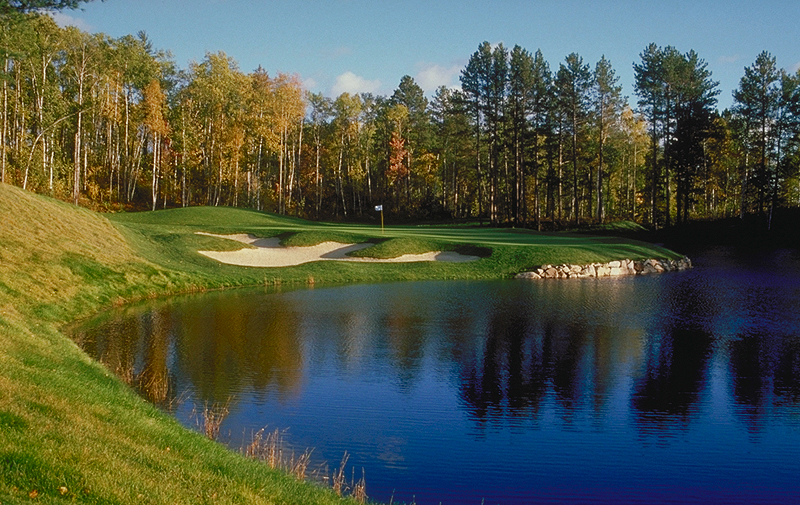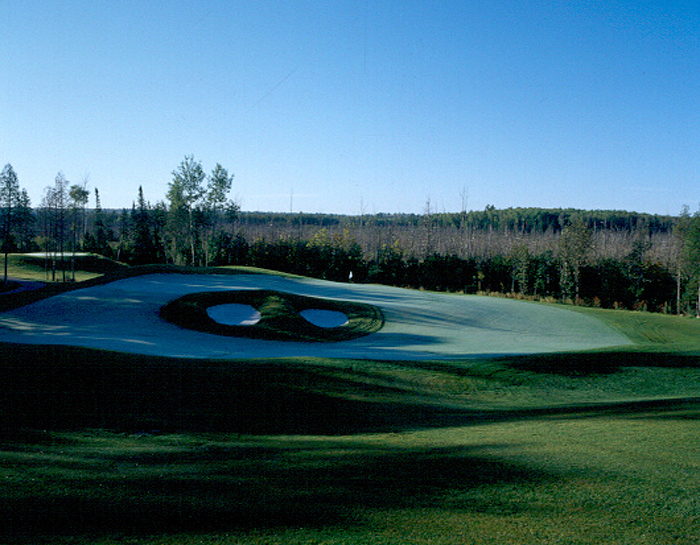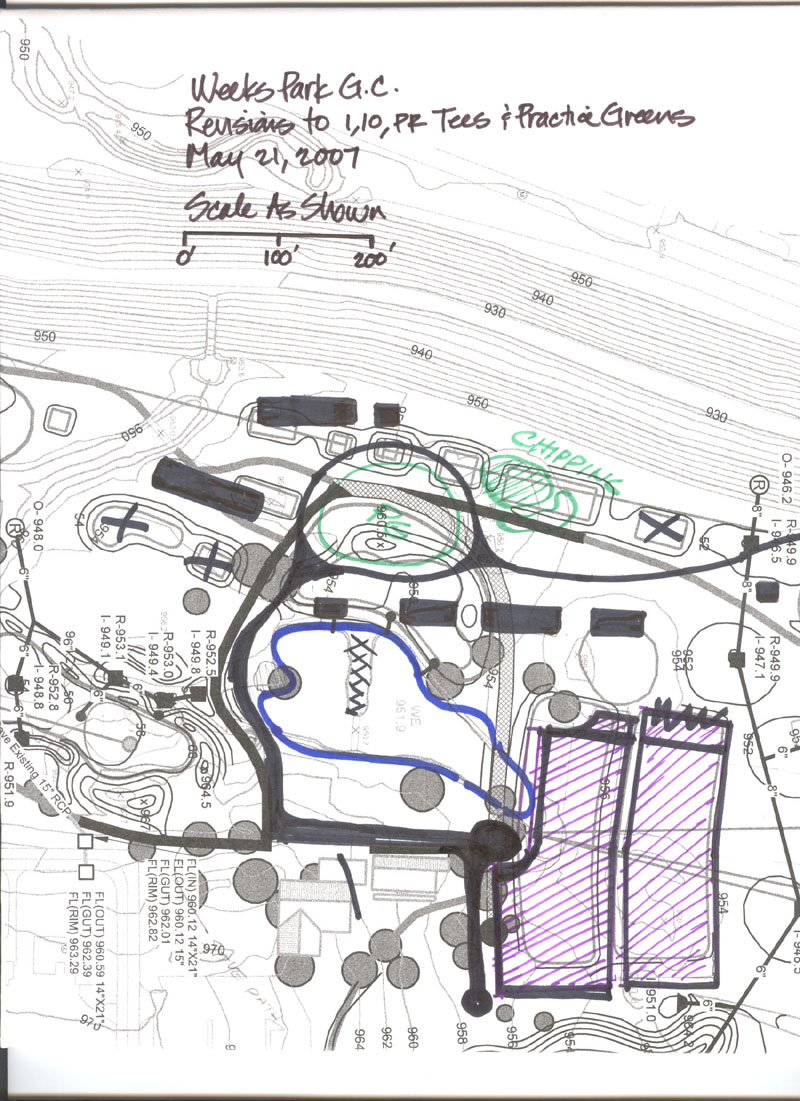Feature Interview with Jeff Brauer
May, 2011
1. How did you get started in golf course architecture?
My next door neighbors were members at Medinah, in suburban Chicago where I grew up. My friend and I snuck on when the courses many Mondays, when they were closed. I fell in love with golf courses. I actually went home after my very first round, at age 12 and told my parents I was going to be a Golf Course Architect. (They told me to do something “where I would use my brain” but I was not to be denied!
Despite reservations, my Dad saw a blurb in the Tribune business section about the ASGCA moving its HQ to Chicago. He brought home a large envelope of ASGCA and National Golf Foundation articles and booklets on golf design, which I pored over. I noticed that Killian and Nugent were in the next suburb, and wrote them. To my surprise, they wrote back, offering to let me come in and see the office. They told me to take drafting in high school and work for landscapers and/or on a golf maintenance crew, and then to take landscape architecture in college, with side classes of aerial photography, turf management, business, soils and surveying, which I did.
When I came out of University of Illinois they felt obligated to hire me, since I had followed their advice, despite a low workload. What sealed the deal was sitting next to them at the state ASLA banquet, and as the night went on, I won the Best Senior Award and then the National ASLA Certificate of Merit. Returning to the table with my second plaque, Dick said, “I’ll see you Monday,” with a resigned tone of voice.
I apprenticed there for seven years until, including the last year with Ken Killian, after they broke up. I was always going to go on my own, and walked into Ken’s office on my 29th birthday, wanting to start before I was 30. I wanted to move south. I went to the local library to look at phone books, and Dallas was the only major city without a yellow page listing for Golf Course Architects, so Dallas it was.
Not long after I moved, Jim Colbert called me to help him in the renovation of a Dick Wilson design in Vegas, which I had started under Killian. Other early jobs included a nine hole expansion in La., when the selection committee was headed by man who had also just started his own business and was sympathetic to “the new guy” and a renovation near Dallas. Both actually signed the same day, and I went from virtually nothing to a real business in a hurry. A year or so later, Larry Nelson’s agent, who was in Dallas, called with some questions about design, and I ended up teaming with him on several projects.
2. What are your design influences?
I am influenced by Killian and Nugent, their mentor Robert Bruce Harris, Dick Wilson, by courses – classic and modern – I have seen or played, and from having worked two college summers on a maintenance crew, and also by my degree in landscape architecture. I may be influenced by family genes – supposedly Dad’s German side had some engineers and Mom’s side had at least one painter.
It’s hard not to be influenced by good mentors, and I had good ones. Harris owned golf courses during the depression and designed for easy maintenance, with big oval bunkers and placed exactly one gang-mower width from the green and gentle slopes for tractor mowing. Harris also instilled an engineering approach to Killian and Nugent, producing elaborate grading and drainage plans. However, Ken and Dick wanted to be stylistically different than Harris, and selected Dick Wilson as their role model over RTJ, albeit ending up with a style something between the two influences.
They also adopted “backing mounds” as a design style, which filters through a few generations of Golf Course Architects later (since some of my associates who have gone on their own still use them, too)
Nugent liked a large scale and bold design elements. He said no architect ever got famous by being timid. Ken was more conservative, and used to say that there was more honor in rebuilding one good green on a modest course than designing a tournament course.
3. What have you learned about design from tour professionals?
I’m a 10 +/- handicap, and I rarely care what I shoot. Tour Pros fill in that “good players” perspective. The two most articulate pros I have worked with are Jim Colbert and Notah Begay III. Both really use strategy on every shot. They taught me that strategic players use everything to their advantage and like “traffic signals” like wind, ground slope and target orientation to say the same thing and suggest a shot. As Colbert once told me, “If a hole dog legs right, the wind blows right, and the target angles right, I‘m going to hit a fade”.
I have also worked with Fred Couples, Steve Elkington (straight ball always) Larry Nelson (draw always) and Bruce Litzke (fade always). Lanny Wadkins could hit all the shots and he relayed the many different shots he played at Riviera, which was fascinating.

1st Hole at Firekeeper, Mayetta, KS (2011, with Notah Begay III)- This photograph shows an emphasis on clearly seen bunkers, leading the eye, and there is a large kick slope on the right of the green to assist timid golfers in finding the green a different way.
4. How do you create interesting par 5’s these days when strong amateur golfers drive it 330 yards and hit seven irons 200 yards?
Basically, I look the other way, because they are such a small percent of golfers, and aren’t the typical players at my courses. Nor, do they hit it 330 every time. We did a par 5 at Firekeeper at 540 yards from the tips, and it was a “tweener” for Notah, so we opened the green up a little to make it more inviting. Go count divots on back tees to convince yourself. There aren’t many because so few people actually play the back tees that I have taken to making them about 15 foot squares.
5. How would sum up your design philosophy to someone who hasn’t seen your work?
I’m influenced by Post WW II design, mostly because while it’s easy to critique that era of design, there are reasons (construction techniques, maintenance costs, business conditions) that have shaped current design, and it seems more “sincere” to embrace “form follows function” than looking “back to the future” or designing something really wild that looks great, but isn’t good golf.
I lean to playability, visibility and receptivity. In computer terms, I am mostly “What you see is what you get.” In general, on any given course, I believe holes are too much alike, rather than too different, so I do borrow from classic ideas of every era, and you might call my style “eclectic.”
I don’t do much earth moving, grading fairways only for vision or drainage, and most of my designs have moved less than 200,000 cubic yards of earth, which is low by modern standards. Still, my courses aren’t the cheapest out there, because I build proper infrastructure, to save money long term.
Going from Medinah to public courses (cue Kramer from Seinfeld) has made me want to bring public golf course design up to country club levels.

6th Hole, Quarry at Giant’s Ridge – We used existing Quarry scars to give a completely different look to the course, in this case building a ramp through it for walkers. My first Best New Winner after placing several courses on the list, but not coming out on top. (Photo by Klemme)
6. Did Killian and Nugent design by formula?
Like most designers, they unconsciously had formulas and I think that era of designers did get too formulaic. Even the top designers had them – Pete Dye once told me that his short approaches had two thirds of the green covered, mid length were half covered, and long shots were only a third covered in front.
The busy designers (Ross, RTJ, etc.) were said to design with “give me a No. 63 here!” George Thomas tried to match greens with shots, too according to his writings. He suggested long skinny greens work best in a tailwind, which straightens out the shot. He like fairway behind long par 4 greens to encourage bold play by reducing punishment. Similarly, cape holes and any carry tee shot are more tempting when downwind, so I try to use those with trailing winds wherever possible.
While some current critics dislike post WWII designs, and blame “formulaic design” the era’s blandness results from designing for maintenance ease over difficulty and aesthetics. Given it was the most practical generation, having survived the Depression and WWII, and probably the least nostalgic time in US history, together with the era of “streamlining” I can see their point, even when many current critics can’t.
Post WWII era designers like Dick Nugent, Bob Graves, William Mitchell, had design formulas, based on proportionality of difficulty to shot length, so green openings, size, etc. were usually sized accordingly. The USGA slope system recognizes the same, and suggests target sizes that accept 2/3 of both low and high handicapper shots. Using empirical field research, their formula calls for green width being 15% of effective approach length for average players and 20% for depth.
I updated the Nugent formulas using Microsoft Excel, adding allowances for uphill, wind, etc., from the actual yardage. It has saved me from building useless bunkers the when the shot was downhill, downwind, etc., and would blow by the “standard” LZ, or under sizing a green where the shot really plays longer. But, it is just one design tool, and I still design mostly intuitively.
Formulas have a bad connotation, because you might pass up a great hole based on formula. As Dick Nugent says, it’s good to break the rules occasionally, but if you break them too often with forced carries, small targets, etc., the design goes from playable to unplayable, unpopular and eventually a renovation candidate.
Using only 18 or 19 templates isn’t good, but my methodology of picking among 40-50 “hip pocket” design ideas (tee shots, approaches, recovery), using each only once, creates variety. Most sites suggest a few holes strongly, while other holes give me some options. I have never been forced a hole on the land. And, my hip pocket list keeps growing – I still study golf courses, and I still doodle design ideas nearly every night and easily come up with a few new ideas per design.
So, I don’t know if I have formulas as much as a lot of ideas waiting around for the right place to use them.

8th Hole, Quarry at Giant’s Ridge – In spots, the old Quarry gives the course a feel like Pine Valley. (Photo by Klemme)
7. You have a natural inclination and interest in the history of golf course architecture. How does that filter through to your work?
I know my designs have more variety in since beginning to include versions of famous (or good) holes in my work. I like Seth Raynor, but I also like Mike Strantz, and have no trouble mixing Raynor’s Redan, Punch Bowl, and Biarritz greens, with a Thomas Mae West, and a Strantz long (or wide) ribbon green, followed by a tiny Ross “fortress green.” I’ll even bunker both sides of an LZ on one hole, like RTJ, because that idea is used so little these days.
Some people say “this hole is different from the rest” and I say, “That’s the whole point.” My overall style ties them together enough, and on most courses, features tend to be too much alike over too different.
At Firekeeper, we built a few tees in Larry Packard’s 1970’s Innisbrook free form style, and those get a lot of comments. But the historic feature I always wanted to use, and found the place for at Firekeeper was the fairway bunker from Royal St. George 4th hole. Our version is also on our 4th hole, and it’s a par 5 like the original used to be, creating the risk reward of carrying the 30 foot deep bunker for a chance to reach the green.
8. You were president of the ASGCA in 1995-6. What role does the ASGCA play in making golf a better sport?
Mainly, our members design good golf courses for a variety of clients and needs.
As an organization, ASGCA advances the interests and the profession of golf course architecture for the benefit of ASGCA members and the game of golf. We try to foster the professionalism through education and fellowship. This continuing education allows each member to increase their skills, in an era where golf courses have increasing technical, economic, community and environmental requirements to meet the needs of golf course owners, developers and communities.
We are really a secondary player to organizations like the PGA in the growth of golf, but we help where we can, and take the industry lead when architectural issues like environmental sustainability are potentially harmful to the long term health of the golf industry.

11th hole – Legend at Giant’s Ridge – Carved out of rugged landscape, this short par three is typical of the Northwoods scenery.
9. The construction costs of many modern courses are proving to be unsustainable. Many courses/clubs have gone into bankruptcy and only the second or third owners are ending up with a cost basis that is sustainable long haul. All of this building occurred under the watch of the ASGCA. Did the ASGCA ever issue guidelines regarding prudent golf course construction costs?
In nearly every era, golf course businesses have had a structural problem in that construction costs usually needed to be subsidized for a course to work financially. For that matter, many other businesses only work with the third owner, too.
We tend to focus about 99% of attention on about 1% of golf courses. Since ASGCA members have designed most of our courses over the years, our members have probably built most of the expensive ones, most of the inexpensive ones, and most of both successes and bankruptcies.
As a group, we have published informational pieces on building affordable facilities, and many including our next President, Rick Phelps have championed affordable golf in both their work and the press. I did a point-counterpoint piece in Golf Course News with Denis Griffiths. I was assigned the less popular “We can’t cut costs” argument, pointing out that building proper infrastructure initially pays long term dividends. I do think “needless” earthmoving, and other “excess” eye candy often provide too little value and can contribute to financial difficulty. It’s part of my professional obligation to strike the right balance on these.
10. What are some specific examples of you stretching a client’s dollar?
About 49 of 50 courses I have designed! As I noted, it’s built into my architectural DNA from Harris, Killian, and Nugent and it never crosses my mind NOT to engineer a course for best value.
In 2004 I totally renovated Indian Creek near Dallas, which cost $3Mil vs. $4 Mil for other current renovations. It made Golf Digest’s “Best Affordable” list and helped turn a $700,000 loss to a $300,000 profit after re-opening on a mid priced ($37-45) public golf course.
Sand Creek Station in Newton, KS made many “best” lists and Golf Magazine told me how nice it was to be able to feature an affordable course in their best new list. Design wise, it offers many historic templates holes, and play increases each year despite the down economy.
Again, I love giving “my peeps” a mid price golf course of quality. As Ken Killian said, what does the most for the world of golf?” I think many golfers perceive my courses as $100 values priced at about half that, and value is what sells cars, houses, and golf to most of America.
11. One of the tenets of the ASGCA is that architects should not criticize fellow architect’s work, somewhat like the Hippocratic Oath for doctors. Yet, there is no doubt that sharp words be those that are found in The Confidential Guide or on GolfClubAtlas.com have helped stimulate the discussion and admiration for golf course architecture. Where do you stand on critiquing the work of fellow architects?
ASGCA only requires that members not promote themselves with false, exaggerated or misleading information, or knowingly make false statements that injure or disparage other architects or projects. All of that seems pretty reasonable to me.
I also agree we should respect the work of other golf course architects. Unless you know the full story, a lot of criticism is really off base. Architect tends to review courses against what they would have done, and magazines tend to review courses in comparison to their top 100 courses, even when a course was built with everyday play in mind.
I have nothing against polite discussion about design theory, or I wouldn’t participate on golf club atlas. I have made a few critiques there, politely, and was also quoted in the updated “Dream Golf” about why Pacific Dunes is harder than I might have made it. So, there is certainly some value in it, if done for the right reasons, but never when it gets to be a free for all, or when a Golf Course Architect is bad mouthing other architects to get business, which rarely works anyway.
12. You have lived in Texas for 33 years and Colonial Country Club has always been the course in Texas for many of those years. How do you think it has withstood the test of time?
Colonial is still the perfect member’s course and has great history. Further, all the pros other than the longest hitters who have trouble bending it around the doglegs seem to love it, so it’s not a bad tournament course. Overall, it’s still a great course, probably ranked where it should be.

3rd hole – Legend at Giant’s Ridge – If this footprint was the highlight of the golf course, I would apologize for it, but it creates options for play and sold a lot of golf shirts for them.
13. Explaining what constitutes a good routing is somewhat difficult to do. Subsequently, it is one of the parts of golf course architecture that is the least written about/least understood. Please describe an original eighteen hole course that you have designed and what makes the routing so good.
I judge routings on whether there are 18 attractive holes and no awkward or unsatisfying ones. I think too many Golf Course Architects readily accept a few clunkers because they “can’t be avoided.”
I prefer routings with few holes needing substantial fairway grading. My best routings come from testing dozens of schemes over many weeks, sometimes taking a week off for fresh perspective. I would say my best routing is the Quarry at Giant’s Ridge. It embodies close green to tee walks, changes of direction, variety in distances, and uses most of the great quarry features for a unique course. But, others are close.
14. You have designed fifty courses yet none have cracked the Golf Magazine or Golf Digest U.S. top 100 lists. How do you feel about such rankings? Are they good for your profession? Who should serve on such panels?
The latest Golf Digest Rankings issue marks the Quarry at Giant’s Ridge with an “*” meaning it rates in top 100 but doesn’t have enough raters. So, I have a course in the top 100. That’s my story, and I’m sticking to it!
I always wanted a course in the top 100, but figured it would be a once in a lifetime opportunity. I also figured we probably already had all the tough, top 100 courses we needed. While I know most magazines have moved away from pure difficulty for ranking, it’s still a criterion. I focus on interesting shots for low (not scratch) and mid handicappers, since they make up the bulk of play. I think “a course you could play every day” is the highest honor a course can achieve.
Top 100 lists have improved design, but also created more difficult courses than I think is good. Golf Digest used to publish their panelist’s comments and a few noted that I tended toward all mid length par 3’s (thinking they are fun for average golfers) so my typical par 3 “tips” yardages are now 140, 180, 220 and 260 yards for more variety and distinction between holes.
But, courses designed for ego, one upmanship, lists or awards, housing, photographs, non-existent tournaments and almost anything other than the golfers who will play it are not likely to play as well as those designed for “form follows function.” We lost sight of true prime function of golf courses.
I think rankings are fun and they are good for the profession in many ways. I don’t think architects should be raters. I believe in the power of numbers in the multi-panelist systems and in the opinions of average golfers over a few “elites” telling us what we ought to like.

7th Hole – Indian Creeks (Creek Course) – A successful remodel of a tired course (with a great routing) that helped them change their balance sheets by over $1Million to the good. (Photo by Munoz)
15. What changes do you see in the future of golf course design and construction based on the new economic world order?
I see a return to an emphasis on practical design aspects of design similar to “practical” the post depression and WWII, repeating Mackenzie’s bunker removal tour in the 30’s, a new emphasis on minimizing bunkers to those that are “in play”, and designing to current maintenance equipment and conditions. I believe one casualty will be lacy edged bunkers. While they look great at Sand Hills, they play average (with some shots unplayable for no particular competitive reason) and can look out of place on urban golf courses, and cost more to maintain. At most economically strapped courses, they will be deemed unworthy of the expense. Looking great won’t save them in most cases.
I am reducing sand bunkers, “downsizing” tees (because of reduced play), flattening most slopes in mounding, (to save water and speed up mowing) and greens (require more space, dry out) and in general, looking at any way to reduce maintenance costs. I am shortening green to tee walks and widening courses to promote faster play, and am a strong advocate for shortening courses from the most used tees. My front tees are now about 4400 yards, and while my father wouldn’t play less than 6000 yards, seniors today avoid courses that don’t have 56-5800 yard tees for them to play.
I think Tour Pro’s driving distance will help shorten other courses. The length disparity is so dramatic and obvious golfers will prefer shorter courses where they can replicate the clubs pros hit on TV, rather than the approximate distances.

17th at Wilderness at Lake Jackson, TX – Typical Houston Low Country Golf Course, which draws play from a larger Houston golf market. This hole uses a George Thomas inspired “Fair Tee” that simply connects out to the fairway.
16. Every architect is available for work. Why should a client employ you?
I usually pitch my ideas on specific visions and solutions for potential clients, since every project is unique and hope my vision matches the Owner’s. I do tout my long time emphasis on public course design, and how that experience helps me give them a really good course resulting in popularity and success. I cite tangible results like “Best New” and Best in State Rankings and the fact that many of my courses buck trends towards declining play, often generating more rounds than competing courses in their markets. While some critics may prefer other designer’s styles, golfers who pay the bills seem to like my particular combo of playability, interest, aesthetics, etc., making me a pretty sound investment as an architect.
17. Do you ever get frustrated with the hiring process employed by owners?
Only on the nine out of ten where they don’t hire us!
Seriously, I view it as my first job to convince the owner, and my fault when I don’t. There are some jobs we go in at a disadvantage, either lacking the name or experience in that type of design (like historic restorations in my case) and I can see why the Owners make the decisions they do. In other cases, it seems like the committee only knows that they need an architect, and the process doesn’t seem really structured to get them the best results.
You can go crazy trying to figure out how or why firms got a job. Some have less than a year of experience, or as my dad used to say, others have the same year of experience 20 times over, never changing their style and repeatedly making the same mistakes. I recently toured a course and drove my cart right into one of the invisible, flat bunkers that the designer had done for years. Does someone really like blah, invisible bunkers to keep hiring him? Doesn’t he want to improve? I once let a staffer go for saying “this is the way we’ve always done it.” I believe I need to keep getting better just to stay even in this hyper competitive market.
The industry probably wonders how I get hired, too. Especially at Colbert Hills, when there are a dozen Kansas State grads working as golf course architects.
I once lost a project to a then new design firm. I offered to show the committee my work and they replied that it might “unfairly influence the decision.” Huh? What could be fairer than looking at everyone’s work and then picking based on what you like the best for your situation? Contrast that to another project I lost when the Owner played similar projects by two architects and told me he just liked the other guy’s design a little better. Who could get mad?
I also got a project once because those committee tours just happened to occur during a rainstorm, and my project was the only one they visited that was so well drained, that it was open for play. That alone was enough to sell them on my work, in part because one of the committee was the civil engineer.
So, you never know just what might get you hired.
18. Once hired, what makes a bad project for you?
Again, it’s the people. I once had a very frustrating project manager, who had some design experience, but believed in bland designs that leaned 100% towards ease of maintenance. He took out some features based on that and I told him to spend the weekend at the local art museum to improve his artistic sensibilities. We are still friends, though and laugh about that now.
If we go into a project that is severely underfunded, or with inexperienced owners, we know that is going to get tough somewhere as financial realities set in for them, and they look for someone to blame other than themselves.
It’s also tough to work with a stubborn contractor, who thinks he knows better or will tell the Owner that he is “saving the Project.” The best ones work with us, and do give us good improvements without blaming anyone. They work as true partners to make the project better than the plans show.
19. So, how much do you vary from the plans that you draw?
I still take pride in drawing plans that are close, and disliked when a few of my employees started saying they didn’t matter at all, so it varies.
The irrigation sprinklers at Opryland all staked out just as depicted on plan, relative to tees, greens, contours, etc., but it was a tight, floodplain site where we had to be right on. I tell contractors that about 15 holes usually get built mostly to plan, but on two or three, I will need to make substantial changes. My changes narrow down from “yards to feet to inches” rather than continually make wholesale changes over and over to no good effect. And, I usually redraw any green or bunker plan based on what I do see and want in the field.
The End





